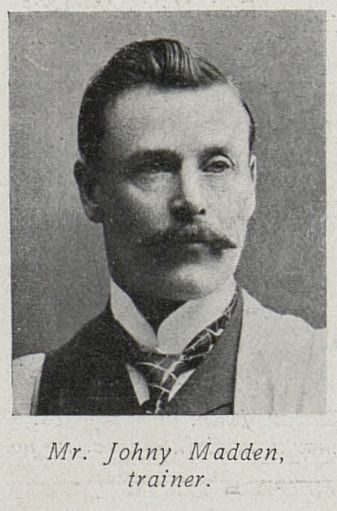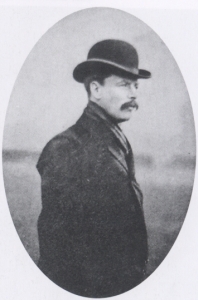M | Player Homepage | A-Z of Players | Players | Players Pics


This particular photo, probably taken in the eighteen nineties, was posed for at the studios of McClure
and McDonald 2 Bothwell Circus, Glasgow, who were then among the foremost photographers in Europe.

John Madden stands extreme left in this Celtic team photo from the early 1890s. The original of this photo was of substantial dimensions and printed on very fine paper, which suggests it may have been published as a supplement to a newspaper or sports magazine. It is difficult to tell whether the photo was studio posed or taken at a football location.
Despite playing for Dumbarton and Celtic, both prominent teams of the time (Willie Maley Celtic’s first manager claimed that a major feat of his club’s early days, was that of becoming the first side to defeat the four Dunbartonshire teams, Alexandria, Dumbarton, Renton and Vale of Leven in one season), Madden never acquired a Scottish Cup winners medal. However, in 1893, he was a regular in the Celtic side that won three League Championships in the early 1890s.
Tom O’Neill with the tea-set ‘won by Madden in a five-a-side tournament in 1890’
A Celtic colleague James Blessington has gone on record stating that in his time, Madden was Scotland’s finest exponent of the stamina sapping five-a-aside version of soccer which was extremely popular at athletics and sports meetings.
The pewter tea set below (now in Hampden Museum) was won by Madden at such a meeting at Celtic Park on Sunday August 9th 1891. On that occasion Mr Dan Crilly, an Irish MP of the Home Rule or Nationalist variety presented the prizes. Mr Crilly was in Scotland on a speaking tour for the purpose of denouncing Charles Stewart Parnell.
The tea set itself sat for many years on the sideboard at the home of Madden’s niece Agnes Madden Quinn. And was displayed in 1988 at Celtic’s Centenary exhibition at the People’s Palace.
Prague 1910. Standing front left, an extremely fit looking forty-five years old Madden with his TJ Slavia team that had just won the league championship.
Up until World War One, situated in Bohemia, Prague had been part of the Austro-Hungarian Empire. Founded in the late eighteen hundreds, TJ Slavia which eventually became a multi-sports club, had its roots in a Czech Nationalist oratorical society.
TJ Slavia claim to be the first honorary member of the English FA, and also to be the only football club in the world that still wears its original match day strip.
Thought to have been issued by TJ Slavia about 1910 as publicity for a tour the club was making.
In 1988 reporting on a ceremony to mark the fortieth anniversary of his death, a Prague newspaper posed the question as to how, Madden, described as ‘this average Scot’ came to be involved with Slavia. A club historian speculated that Madden had been recommended to Slavia by an Englishman, George Payne, who as well as having business interests in Prague, had, in the late eighteen nineties, been a team mate of Madden’s at Tottenham Hotspur.
The card itself, with its ‘John Madden Glasgow Rangers’ legend, lends credence to a story from nearer home. In late 1904, Slavia were in the market for a Scottish coach, preferably John Tait Robertson of Rangers. Born in Dumbarton High Street, Robertson with hopes of a career in journalism was not particularly interested in a job in Prague.
Apparently Madden, Robertson and Findlay Speedie another Dumbarton man with Rangers connections, colluded to deceive Slavia. Madden was photographed dressed in a Rangers’ jersey and international cap belonging to either Speedie or Robertson and made of to Prague with proof of his Rangers identity.
Around about 1910 Robertson became the first professional manager of Chelsea. Eventually as coach of the Rapide and MTK clubs of Vienna and Budapest, he met up with Madden on the continent where Madden informed him that coaching in Prague was infinitely preferable to hammering down hot rivets in a Clydeside shipyard.




















